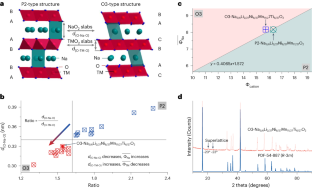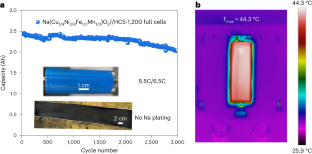2024-02-19 オランダ・デルフト工科大学(TUDelft)
<関連情報>
- https://www.tudelft.nl/en/2024/tnw/delft-researchers-take-next-step-towards-better-batteries-with-widely-available-materials
- https://www.nature.com/articles/s41893-024-01266-1
- https://www.nature.com/articles/s41560-023-01414-5
ナトリウムイオン電池用高速充電高電圧層状正極 Fast-charge high-voltage layered cathodes for sodium-ion batteries
Qidi Wang,Dong Zhou,Chenglong Zhao,Jianlin Wang,Hao Guo,Liguang Wang,Zhenpeng Yao,Deniz Wong,Götz Schuck,Xuedong Bai,Jun Lu & Marnix Wagemaker
Nature Sustainability Published:15 February 2024
DOI:https://doi.org/10.1038/s41893-024-01266-1

Abstract
Sodium-ion batteries have not only garnered substantial attention for grid-scale energy storage owing to the higher abundance of sodium compared with lithium, but also present the possibility of fast charging because of the inherently higher sodium-ion mobility. However, it remains a phenomenal challenge to achieve a combination of these merits, given the complex structural chemistry of sodium-ion oxide materials. Here we show that O3-type sodium-ion layered cathodes (for example, Na5/6Li2/27Ni8/27Mn11/27Ti6/27O2) have the potential to attain high power density, high energy density (260 Wh kg−1 at the electrode level) and long cycle life (capacity retention of 80% over 700 cycles in full cells). The design involves introduction of characteristic P3-structural motifs into an O3-type framework that serves to promote sodium-ion diffusivity and address detrimental transition metal migration and phase transition at a high state of charge. This study provides a principle for the rational design of sodium-ion layered oxide electrodes and advances the understanding of the composition–structure–property relationships of oxide cathode materials.
硬質炭素負極における高速充電の起源 Origin of fast charging in hard carbon anodes
Yuqi Li,Alexandros Vasileiadis,Quan Zhou,Yaxiang Lu,Qingshi Meng,Yu Li,Pierfrancesco Ombrini,Jiabin Zhao,Zhao Chen,Yaoshen Niu,Xingguo Qi,Fei Xie,Remco van der Jagt,Swapna Ganapathy,Maria-Magdalena Titirici,Hong Li,Liquan Chen,Marnix Wagemaker & Yong-Sheng Hu
Nature Energy Published:03 January 2024
DOI:https://doi.org/10.1038/s41560-023-01414-5
An Author Correction to this article was published on 10 January 2024
This article has been updated

Abstract
Transport electrification and grid storage hinge largely on fast-charging capabilities of Li- and Na-ion batteries, but anodes such as graphite with plating issues drive the scientific focus towards anodes with slopped storage potentials. Here we report fast charging of ampere-hour-level full Na-ion batteries within about 9 minutes for continuous 3,000 cycles based on hard carbon anodes. These anodes, in addition to displaying a sloped storage voltage, provide capacity at a nearly constant voltage just above the plating potential, without observing Na-metal plating under high areal capacity. Comparing the electrochemical behaviour of Li and Na in hard carbon through experimental and computational techniques, a unified storage mechanism relying on the dimensions of wedge nanopores and drawing parallels with underpotential deposition for metals is brought forward, providing a rational guide for achieving fast storage in hard carbon anodes.



